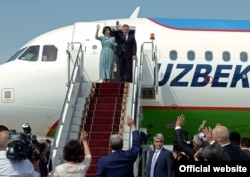
Uzbekistan is said to be expecting guests from Kyrgyzstan, and they're the sort of guests that Uzbek officials are unaccustomed to seeing in Tashkent.
RFE/RL's Kyrgyz Service, known locally as Azattyk, reports that the Kyrgyz delegation is coming to discuss plans for a massive hydropower plant, called Kambar-Ata-1, that would make use of the Naryn River in Kyrgyzstan. Shortly after crossing into Uzbekistan, the Naryn joins one of Central Asia's two great rivers, replenishing the Syr-Darya as it snakes its way through the agricultural lands of eastern Uzbekistan.
Previously, the Uzbek government's comments on Kambar-Ata-1 were mostly limited to opposing the project and warning of consequences if Kyrgyzstan went ahead with the dam and Uzbeks suddenly found themselves lacking for water.
Now, the Kyrgyz delegation is reportedly expected to hear offers, not threats.
Shavkat Mirziyoev, who took over as Uzbekistan's president after the death of longtime leader Islam Karimov in the late summer of 2016, appears to have far friendlier regional policies than his predecessor.
Mirziyoev made some big promises after he became president. Sometimes it is difficult to see progress on Mirziyoev's plans for domestic reforms, but the impending visit of the Kygyz delegation suggests that Mirziyoev's pledge to improve ties with his Central Asian neighbors is moving forward.
During his visit to Kyrgyzstan in September 2017, Mirziyoev said Uzbekistan would help build Kambar-Ata-1. That marked a reversal of Karimov's policy on large hydropower plants in Kyrgyzstan and Tajikistan. In October 2017, during then-Kyrgyz President Almazbek Atambaev's official visit to Uzbekistan, state company Uzbekhydroenergo signed a memorandum of cooperation with Kyrgyz National Energy Holding Company on construction of Kambar-Ata-1.
There has been little or no progress on Kambar-Ata-1 since then. Which is why news of the impending Kyrgyz visit seems significant.
Tashkent has indicated it wants to invest in and help construct Kambar-Ata-1, a project with an estimated price tag of more than $2 billion. How much Uzbekistan is willing to invest and, maybe more importantly, where it might find the money, remain unclear. Uzbekistan has its own $4.35 billion program to expand the use of hydroelectricity by 2030.
The project has a long history of disappointment.
Kambar-Ata-1 and the Upper Naryn cascade were the brainchilds of Soviet planners in the 1980s. The Kambar-Ata-1 dam is intended to generate some 1,940 megawatts of electricity annually. Some work was done in the latter half of that decade, but it ended when the Soviet Union collapsed in 1991.
Russia showed new interest in the project and signed a deal in 2008, and Russian companies RusHydro and RAO UES agreed -- seemingly reluctantly -- to take part in the construction of Kambar-Ata-1 and contribute some $2 billion toward construction of Kambar-Ata-1 and the Upper Naryn cascade projects. But reports later suggested that then-Kyrgyz President Kurmanbek Bakiev's son, Maksim, who had broad powers over Kyrgyzstan's economy, opted to use part of an initial $450 million tranche to reinvest in projects outside Kyrgyzstan. As a result, the Kremlin was said to have pressed to suspend the remainder of the loan.
RusHydro and the Kyrgyz government signed a new deal in 2012 to build the Upper Naryn cascade. Some $37 million worth of work was done, but by December 2015 Atambaev was saying, "The reality is such that today, unfortunately, our Russian friends will not be able to implement these projects" in reference to Kambar-Ata-1 and the Naryn Cascade projects. In January 2016, Kyrgyzstan's parliament voted to annul the deal with Russia.
Despite assurances from some Kyrgyz officials that replacement investors could easily be found, reportedly the only company to show serious subsequent interest in the project was a little-known group from the Czech Republic called Liglass that pledged in July 2017 to build part of the Naryn Cascade project. Liglass turned out to have little or no experience building hydropower projects and was reportedly unwilling or unable to repay the $37 million owed to RusHydro. The contract with Liglass was canceled in September 2017.
Uzbekistan's new interest in Kambar-Ata-1 at least serves as a reminder to other potential investors of the project's existence, and Uzbekistan's support for its construction is also one less concern for other potential investors. And no matter who builds it, Uzbekistan would likely be among the first customers for electricity from Kambar-Ata-1.
There is seemingly good news in Kazakh-Uzbek relations as well. On February 20, Kazakhstan's Mazhilis, the lower house of parliament, ratified an agreement on energy cooperation between Kazakhstan and Uzbekistan. Kazakh Energy Minister Kanat Bozumbayev told the Mazhilis the agreement allows for the "supply of crude oil to Uzbekistan for processing at local refineries and the uninterrupted supply of natural gas to southern Kazakhstan in autumn and winter."
Just a few months into his presidency, in early 2017, Mirziyoev visited Kazakhstan in March and Russia in April. Mirziyoev's agenda in both countries included seeking agreements for oil supplies for Uzbekistan.
According to the BP Statistical Review of World Energy for 2018, Uzbekistan has some 600 million barrels of oil. But oil production has been in decline there for 20 years. In 1998, Uzbekistan's oil production peaked at some 191,000 barrels per day (bpd). It dropped to 102,000 bpd in 2008, the last year Uzbekistan's oil production topped 100,000 bpd, and in 2017 the figure was 54,000 bpd.
Uzbekistan's three refineries -- Bukhara (capacity 50,000 bpd), Alty-Arik (capacity 66,000 bpd), and Ferghana (some 108,00 bpd) -- have been operating at about half capacity for several years. Uzbekistan is building a fourth refinery in Jizzakh (capacity some 100,000 bpd), at an estimated cost of some $2.2 billion.
Kazakh Energy Minister Bozumbaev told the Mazhilis that "Uzbekistan is interested in buying up to 5 million tons of oil per year."
That is the planned capacity of the Jizzakh refinery.
Bozumbaev also said Uzbekistan was hoping that of that 5 million tons of oil, Kazakhstan would supply 2 million tons and Russia 3 million tons.
That is actually less than Mirziyoev was seeking in the spring of 2017, when he asked Kazakhstan to supply 1 million tons and Russia some 10 million tons.
However, the request also required repair of an existing Soviet-era pipeline -- the Omsk-Pavlodar-Shymkent-Shagyr pipeline -- leading from Russia through Kazakhstan to near Uzbekistan's border.
Bozumbaev said some 68,000 tons of Russian oil was shipped via Kazakhstan in 2017 and some 36,000 tons in 2018. That figure should increase significantly once Uzbekistan finishes the oil pipeline it is building from the site of the Jizzakh refinery to the border with Kazakhstan. Currently, oil is unloaded in Shagyr and transported the remainder of the way to Uzbekistan on railway containers.
Bozumbaev also noted that, under a deal between KazTransGaz and UzTransGaz, the Gazli-Shymkent gas pipeline started operation at the end of last year, bringing an additional source of gas to areas of southern Kazakhstan as well as providing Uzbekistan's capital with more gas.
It seems fitting that energy agreements are now helping to tie the Central Asian states together. It was energy agreements that helped divide the Central Asian countries shortly after they became independent, and many would argue that Uzbekistan's policies were responsible.
The Soviet-era unified energy grid in Central Asia had helped distribute power where it was needed in the region. Gas from Uzbekistan powered and heated towns and cities in southern Kazakhstan, southern Kyrgyzstan, and western Tajikistan.
But under President Karimov, Uzbekistan frequently halted gas supplies to these areas in neighboring countries. The reason that was cited was unpaid bills, but the timing often seemed to indicate Tashkent was expressing displeasure with policies in Kazakhstan, Kyrgyzstan, and Tajikistan by cutting off the taps.
The result was Kazakhstan's accelerated need to gasify the south of the country by sourcing fields in western Kazakhstan. Kyrgyzstan and Tajikistan tired of the frequent gas cutoffs several years ago and increased domestic production of coal for use in thermal power plants, which is almost surely one of the reasons the Kyrgyz capital, Bishkek, has seen a noticeable increase in smog in recent years.
Failure to cooperate on energy issues has already cost Central Asians a great deal. Perhaps a new era of energy cooperation can help drive not only better regional relations but better access to power and heat for more of Central Asia's inhabitants.









